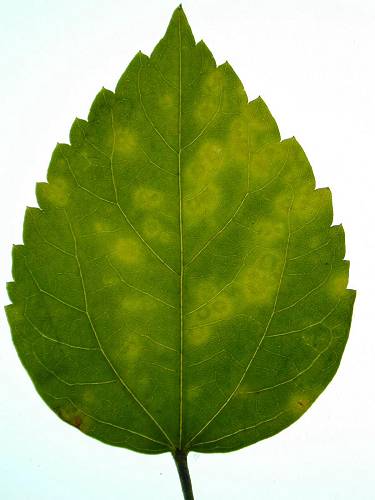|

June 2000. Aibika or bele (Abelmoschus manihot), a perennial malvaceous shrub, is cultivated extensively in some Melanesian countries for its highly nutritious leaves and shoot tips. During preliminary surveys of major crop species in some South Pacific Island countries, virus-like leaf symptoms were frequently found in aibika plants grown in Fiji, Papua New Guinea, Solomon Islands and Vanuatu. A virus isolated from such plants was subsequently identified as Hibiscus chlorotic ringspot virus (HCRSV). This isolate induced symptoms in indicator plant species indistinguishable from those of HCRSV from Hibiscus rosa-sinensis; both isolates induced local lesions followed by systemic leaf chlorosis in H cannabinus (kenaf), and local lesions only in Chenopodium quinoa, Cyamopsis tetragonoloba, Dolichus biflorus, Gossypium hirsutum and Phaseolus vulgaris. Purified preparations of the isolated virus from infected kenaf seedlings contained isometric particles c.28 nm in diameter which had properties typical of carmoviruses. An antiserum to HCRSV from H rosa-sinensis reacted with the virus from A manihot to its homologous titre in precipitin tube tests, ELISA and immunosorbent electron microscopy, and was subsequently used in ELISA to detect infection in aibika.
HCRSV has hitherto been reported to occur only in the ornamental shrub H rosa-sinensis (Waterworth, 1980; Lawson, 1994; Raju, 1985); its natural occurrence in a major food crop in some South Pacific Island countries is, therefore, of particular local importance. HCRSV is undoubtedly disseminated in vegetative propagules from infected aibika and H. rosa-sinensis plants; however, it is not seed-transmitted in either of its natural hosts, and its mode of local spread is unknown. It thus remains to be determined if, like some other carmoviruses (Morris & Carrington, 1988), it is transmitted by beetles, by the soilborne fungus Olpidium bornavanus, abiotically in soil, or mechanically during cultivation and harvesting.
References
Lawson RH (1994) Hibiscus. In: Loebenstein G, Lawson RH, Brunt AA, eds. Virus and Virus-like Diseases of Bulb and Flower Crops. Chichester, UK; Rehovot, Israel: Wiley & Balaban, 476-481.
Morris TJ, Carrington JC (1988) The Plant Viruses Vol.3: Polyhedral Virions with Monopartite RNA Genomes. New York, USA: Plenum Press, 73-112.
Raju BC (1985) Occurrence of chlorotic ringspot virus in commercial Hibiscus rosa-sinensis cultivars. Acta Horticulturae 164, 273-280.
Waterworth H (1980) CMI/AAB Descriptions of Plant Viruses No.227, 4 pp.
PestNet was asked about the implications of the report on this virus in the Pacific. Previous to the report of HCRSV in aibika, the virus had been found only in Hibiscus rosa-sinensis (common hibiscus) in Pacific Islands and elsewhere. This report can be found in the Survey of Agricultural Pests and Diseases (1984),
published by the Forum/UNDP/FAO. Thus, the occurrence of the virus in a major food plant in the Pacific was obviously of interest.
The discovery of the virus originated from the work of Steve Preston and Losavati Naivalulevu in Fiji under PRAP, the Pacific Regional Agricultural Programme. The idea was to improve the varieties of aibika with importations from Papua New Guinea. Breeding was a possibility with Monica Raghwan looking at the biology and genetics of aibika. Seedlings were introduced to Fiji, screened for quality and then because they had become infected by HCRSV they were regrown from meristems (and indexed by Alan Brunt). Some Fiji clones were also included.
The work was very successful and plants were obtained free from virus. They are now in the Regional Germplasm Centre at SPC. Unfortunately, they cannot yet be distributed as permission has not been obtained from Papua New Guinea and Fiji. Some of the plants have high vitamin C content and also DNA fingerprints show that the material from PNG is more diverse than that of Fiji.
What the virus does to aibika, other than giving it yellow spots, rings and vein-banding, is not known. And how quickly virus-tested plants become re-infected is not known either.
|
